Who was William Sheldon?
William Sheldon (1898-1977) was an American psychologist who devoted his life to observing the variety of human bodies and temperaments. He taught and did research at a number of U.S.universities and is best known for his series of books on the human constitution. He was a keen observer of animals and birds as a child, and he turned this talent to good effect by becoming an avid people-watcher, and out of his observations he gradually elaborated his typology.
The Basic Components of Physique
For his study of the human physique, Dr. Sheldon started with 4,000 photographs of college-age men, which showed front, back and side views. By carefully examining these photos he discovered that there were three fundamental elements which, when combined together, made up all these physiques or somatotypes. With great effort and ingenuity he worked out ways to measure these three components and to express them numerically so that every human body could be described in terms of three numbers, and that two independent observers could arrive at very similar results in determining a person's body type. These basic elements he named endomorphy, mesomorphy and ectomorphy, for they seemed to derive from the three layers of the human embryo, the endoderm, the mesoderm and the ectoderm.
Endomorphy is centered on the abdomen, and the whole digestive system.
Mesomorphy is focused on the muscles and the circulatory system.
Ectomorphy is related to the brain and the nervous system.
We have all three elements in our bodily makeup, just as we all have digestive, circulatory and nervous systems. No one is simply an endomorph without having at the same time some mesomorphy and ectomorphy, but we have these components in varying degrees. Sheldon evaluated the degree a component was present on a scale ranging from one to seven, with one as the minimum and seven as the maximum.
The Extreme Endomorph - Roundness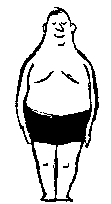
The easiest way to get an idea of the variety of human physiques is by looking at the three extremes, even though in actual life the various combinations are much more common. According to Sheldon's system a 7-1-1 (seven-one-one) is the most extreme endomorph with minimal mesomorphy and ectomorphy. In this physique the body is round and soft, as if all the mass had been concentrated in the abdominal area. In fact, the large intestine of an extreme endomorph can be two or three times the length of that of an ectomorph. Sheldon likened this abdomen to a powerful boiler room with fine powers of assimilation. The arms and legs of the extreme endomorph are short and tapering, and the hands and feet comparatively small, with the upper arms and thighs being hammed and more developed than the lower arms and legs. The body has smooth contours without projecting bones, and a high waist. There is some development of the breast in the male and a fullness of the buttocks. The skin is soft and smooth like that of an apple, and there is a tendency towards premature baldness beginning at the top of the head and spreading in a polished circle. The hair is fine and the whole head is spherical. The head is large and the face broad and relaxed with the features blending into an over-all impression of roundness. The head is like a pumpkin sitting on a barrel, and the abdomen is like a sphere with the chest attached to it like an inverted funnel.
Sheldon imagined the body of the endomorph as a balloon whose walls were thinner at the abdomen and thicker further away. When the balloon was inflated it was largest at the abdomen and smallest at the farthest extremities. Santa Claus is our society's image of the extreme endomorph.
The Extreme Mesomorph - Muscles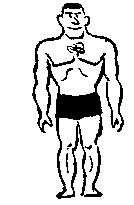
In the extremely mesomorphic physique, or 1-7-1, there is a squareness and hardness of the body due to large bones and well-defined muscles. The chest area, which Sheldon likened to an engine room, dominates over the abdominal area and tapers to a relatively narrow, low waist. The bones and muscles of the head are prominent as well, with clearly defined cheek bones and a square, heavy jaw. The face is long and broad and the head tends towards a cubical shape. The muscles on either side of the neck create a pyramid-like effect. Both the lower and upper arms and legs are well-developed and the wrists and fingers are heavy and massive. The skin is thick and tends towards coarseness. It takes and holds a tan well and can develop a leathery appearance with heavy wrinkles. Sheldon compared it to the skin of an orange. The hair is basically heavy-textured, and baldness, when it appears, usually starts at the front of the head. The extreme mesomorph is Mr. Universe or Tarzan.
Sheldon's initial work with body and temperament types was based mostly on men, and it is in the description of the extreme mesomorph that we have the most need to develop a corresponding female mesomorphic description. Women on the whole tend to have less mesomorphy than men and more endomorphy. Women who are primarily mesomorphs rarely show the same degree of sharp angularity, prominent bone structure and highly relieved muscles found in their male counterparts. Their contours are smoother, yet the chest area clearly dominates over the abdominal area and both upper and lower arms and legs are well-muscled. The skin tends to be finer than in the male mesomorph, but shows some of the same characteristics in terms of tanning and wrinkling.
The Extreme Ectomorph - Linear
The highly ectomorphic physique, or 1-1-7, is fragile and delicate with light bones and slight muscles. The limbs are relatively long and the shoulders droop. In contrast to the compactness of the endomorph and mesomorph, the ectomorph is extended in space and linear. The ribs are visible and delicate and the thighs and upper arms weak. The fingers, toes and neck are long. The features of the face are sharp and fragile, and the shape of the face as a whole is triangular with the point of the triangle at the chin. The teeth are of ten crowded in the lower jaw which is somewhat receding. The skin is dry and is like the outer skin of an onion. It tends to burn and peel easily and not retain a tan. The relatively great bodily area in relation to mass makes the ectomorph suffer from extreme heat or cold. The hair is fine and fast-growing and sometimes difficult to keep in place. Baldness is rare. The extreme ectomorph in our society is the absent-minded professor or Ichabod Crane.
Body Type Recognition
Once we had grasped these three basic elements we tried to recognize them in ourselves and our friends. We, indeed, found some people who were extreme endomorphs, or mesomorphs or ectomorphs, with little of the other components, but there were not many of them. Most of the people we knew were a bewildering variety of combinations, and we practiced mentally weighing how much of each component they had. Jim, for example, had very little endomorphy. He was one of those infuriating people who could eat and eat and never seem to gain a pound. He had some mesomorphy, but probably not as much as the average man. But he did have a lot of ectomorphy. He was tall and thin with long arms and legs, and a slight stoop to his shoulders. One friend was muscular and lean, while another was muscular and bulky. And so on. And slowly we began to recognize eight basic body types.
We have already met the first three in which one of the components stands out. Sheldon liked to draw a body type diagram on which he plotted the different body types. Here's where he placed the extreme endomorph, mesomorph and ectomorph:
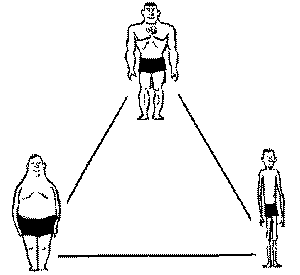
Other people were strong in two elements, and had less of the third. They fell in between the poles of Sheldon's diagram. Four of these combinations captured our attention. There was the hefty muscular person, the muscular thin person, and close to him, the thinner yet still muscular person, and between the ectomorph and the endomorph the person who was spread out and round without really being muscular.

Finally there were the people who had a lot of each component, and they fell right in the middle of Sheldon's diagram, and the completed diagram looked like this:
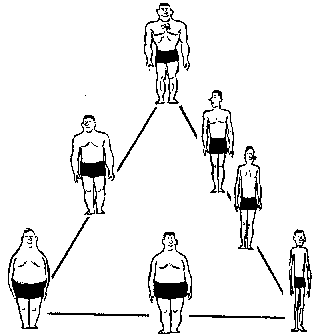
If we take a tour of Sheldon's body type diagram, the endomorph's silhouette looks like a pear. Further up north we meet the endomorphic mesomorph. His abdomen is not quite as massive. His shoulders are bulkier, and this creates a rectangular shape. Much of the softness of the endomorph is gone, replaced by a feeling of solidness. The endomorphic mesomorph is like a bull. Once we hit the extreme mesomorphic pole the bulk of the abdomen has dwindled even further, and there's a strong contrast between the relatively narrow waist and hips and the powerful shoulders and arms. Going down the other side towards the ectomorphic pole we have the ectomorphic mesomorph. He is less heavily built, but still muscular. His neighbor to the south has an equal measure of mesomorphy and ectomorphy, making him thin and muscular. Then comes the more extreme ectomorph, and between him and the endomorph, the ectomorphic endomorph, who is perhaps the hardest to recognize. He is spread out and round without being muscular. In the middle are mid-range physiques well endowed with all the basic elements. And somewhere in this panoramic rainbow of physiques is you. Can you find yourself?
Body type recognition is easier than figuring out psychological types because bodies are naturally much more visible. But it is still a skill that has to be acquired by practice. And Sheldon had it in the highest degree. He was a consummate body type tracker. He didn't limit himself to his laboratory photographs, but wandered about beaches and rode the subway in search of interesting and unusual physiques. He could look across a street and tell the difference between a 6-2-3 and a 6-3-2. This level of skill took a lifetime of dedication, but it is possible for us to acquire the basics if we work at it.
One of the unresolved problems of body type recognition is the question of the physiques of women. I have already mentioned that they are more endomorphic and less mesomorphic, but they are also more mid-range. You see more extreme physiques among men than among women, except for the endomorphs. Women are grouped more toward the cent of the body type diagram and that makes their somatotypes harder to distinguish from one another. A female ectomorph, for example, often has a lot more endomorphy than a male ectomorph. But still and all, it's possible to find the eight basic body types among women as well as men.
Sheldon's Temperament Types
The classification of body types was not Sheldon's ultimate goal. He wanted to help resolve the age-old question of whether our body type was connected with the way we acted. In short, he wanted to explore the link between body and temperament.
Temperament explores how people eat and sleep, laugh and snore, speak and walk. Temperament is body type in action. Sheldon's procedure in looking for the basic components of temperament was much like the one he used in discovering the body type components. He interviewed in depth several hundred people and tried to find traits which would describe the basic elements of their behavior. He found there were three basic components which he called viscerotonia, somatotonia and cerebrotonia, and eventually named endotonia, mesotonia and ectotonia.
Endotonia is seen in the love of relaxation, comfort, food and people.
Mesotonia is centered on assertiveness and a love of action.
Ectotonia focuses on privacy, restraint and a highly developed self-awareness.
Sheldon devised a way of numerically rating the strength of each area based on a check-list of 60 characteristics (see the end of this chapter for a simplfied version) that describe the basic components. The 7-1-1 was the extreme endotonic, the 1-7-1 the extreme mesotonic and the 1-1-7 the extreme ectotonic. He found a strong correspondence between the endomorphic body type and the endotonic temperament, the mesomorphic body type and the mesotonic temperament, and the ectomorphic body type and the ectotonic temperament. Just as in our body type we have all three elements, so, too, with our temperament. A look at the three extremes in temperament will give us some idea of what these components are like.
The Extreme Endotonic - Friendliness
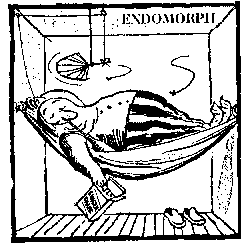
The endotonic shows a splendid ability to eat, digest and socialize. A good deal of his energy is oriented around food, and he enjoys sitting around after a good meal and letting the digestive process proceed without disturbance. Endotonics live far from the upsets and nervous stomachs of the ectotonics. They fall readily to sleep and their sleep is deep and easy; they lie limp and sprawled out and frequently snore.
Endotonics are relaxed and slow-moving. Their breathing comes from the abdomen and is deep and regular. Their speech is unhurried and their limbs often limp. They like sitting in a well-upholstered chair and relaxing. All their reactions are slow, and this is a reflection on a temperament level of a basal metabolism, pulse, breathing rate and temperature which are all often slower and lower than average. The circulation in their hands and feet tends to be poor. Sheldon calls these people biologically introverted organisms. It is as if all the energy is focused on the abdominal area, leaving less free to be expressed in the limbs and face, and giving the impression of a lack of intensity.
Sheldon felt that biological introversion gave rise to psychological extraversion. Since the bodies of the endotonics are so focused on the central digestive system, they need and crave social stimulation in order to feel complete on the social level. Groups of people, rather than fatiguing them, stimulate them to the proper level of social interaction. The assimilative powers that on the physical level were oriented to food, now on the social level draw them to people.
The endotonics love to socialize their eating, and the sharing of meals becomes an event of the highest importance. They treat guests well. They love company and feel more complete with other people around. They like people simply because they are people. They have a strong desire to be liked and approved of, and this often leads them to be very conventional in their choices in order not to run the risk of social disapproval. The endotonics are open and even with their emotions which seem to flow out of them without any inhibitions. Whether they are happy or sad, they want the people around them to know about it, and if others express emotion they react directly and convincingly in sympathy. When an endotonic has been drinking he becomes even more jovial and radiates an expansive love of people. Endotonics are family-oriented and love babies and young children and have highly developed maternal instincts.
In summary, they love assimilation both on the physical and social level. They love to eat and digest, to be part of their family and community, to like and be liked and to rest and relax. They crave food and affection and abhor isolation and disapproval. They express affection and approval readily and need both back in kind.
The Extreme Mesotonic - Action
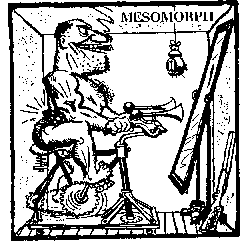
In endotonia the stomach was the focus of attention, but in mesotonia it is the muscles. The mesotonic is well-endowed with them, or to put it another way, the mesotonic's muscles seem to have a mind of their own. They are always ready for action, and good posture is natural to them. They get up with plenty of energy and seem tireless. They can work for long periods of time and both need and like to exercise. They like to be out doing things. If they are forced into inactivity they become restless and dejected.
The mesotonic tends to eat his food rapidly and somewhat randomly, often neglecting set meal times. He sleeps the least of the three types and sometimes contents himself with six hours. He is an active sleeper who thrashes about. He shows an insensitivity to pain and a tendency to high blood pressure and large blood vessels.
The mesotonic has no hesitation in approaching people and making known his wants and desires. The tendency to think with his muscles and find exhilaration in their use leads him to enjoy taking chances and risks, even when the actual gain is well-known to be minimal. They can become fond of gambling and fast driving and are generally physically fearless. They can be either difficult and argumentative, or slow to anger, but always with the capacity to act out physically and usually with some sort of history of having done so on special occasions.
This physical drive manifests itself on the psychological level in a sense of competition. The mesotonic wants to win and pushes himself forward. He is unhesitant about the all-out pursuit of the goal he seeks. Associated with this trait is a certain psychological callousness. He tends to walk roughshod over the obstacles in his path and the people who stand in the way of his achieving what he wants. On the positive side this is called being practical and free from sentimentality, but on the negative side it is called ruthlessness or obnoxious aggressiveness.
This outward energetic flow makes mesotonics generally noisy. They bustle about doing things and since their inhibitions are low, the attendant noise does not bother them. Their voices carry and sometimes boom out as if speech were another form of exercise. When alcohol reduces their inhibitions, they become more assertive and aggressive. When trouble strikes they revert to their most fundamental form of behavior and seek action of some sort. Mesotonics tend to glorify that period of youthful activities where physical powers reach their peak, or perhaps more accurately the period of youth that best symbolizes a sense of endless vitality and activity. This glorification of youth goes hand-in-hand with the early maturing of the mesotonic organism, both facially and muscularly. They look older than their chronological age. The extraversion of action that is so strong here goes together with a lack of awareness of what is happening on the subjective level. The quickness with which the mesotonic can make decisions is compensated for by a relative unawareness of the other parts of his personality. He tends to be cut off from his dream life. He likes wide-open spaces and freedom from the restraint of clothes.
As we saw in the case of the mesomorphic physique, Sheldon's portrait of the mesotonic is more male than female. The female mesotonic shows the same extraversion of action, but how this action expresses itself has a different quality. There is not the same overt physical combativeness and competitive aggressiveness. The action is more muted and flows in more socially acceptable channels. The mesotonic woman should be compared not with mesotonic men but with other women, and it is in relationship to other women that she shows the distinctive mesotonic traits in a feminine way.
Sheldon felt that estimating the degree of mesotonia was the most difficult part of evaluating a person's temperament. At times people with well-developed mesotonia can give the surface appearance of exceptional calmness and amiability. This is particularly true of the extreme mesomorphs of above average height who form a kind of mesomorphic royalty. They expect and get special treatment. Sheldon likened them to big cats who go around with their claws retracted, and only when provoked or in the midst of a crisis does their mesotonia show itself clearly.
The Extreme Ectotonic - Reflection

The outstanding characteristic of the ectotonic is his finely-tuned receptive system. His spread-out body acts like a giant antenna picking up all sorts of inputs. Sheldon calls the ectotonic a biologically extraverted organism, which is compensated for by psychological introversion. Since the whole organism is sensitive to stimulation, the ectotonic develops a series of characteristic strategies by which he tries to cut down on it. He is like a sonar operator who must constantly be wary of a sudden loud noise breaking in on the delicate sounds he is trying to trace. He likes to cross his legs and curl up as if he is trying to minimize his exposure to the exterior world. He tries to avoid making noise and being subjected to it. He shrinks from crowds and large groups of people and likes small, protected places.
The ectotonic suffers from a quick onset of hunger and a quick satiation of it. He is drawn to a high protein, high calorie diet, with frequent snacking to match his small digestive system. He has a nervous stomach and bowels. He is a quiet sleeper, but a light one, and he is often plagued by insomnia. He tends to sleep on one side with his legs drawn up, and his sleep, though slow in coming, can be hard to shake off. His energy level is low, while his reactions are fast he suffers from a quasi-chronic fatigue and must protect himself from the temptation to exercise heavily. His blood pressure is usually low and his respiration shallow and rapid with a fast and weak pulse. His temperature is elevated slightly above normal and it rises rapidly at the onset of illness. The ectotonic is resistant to many major diseases, but suffers excessively from insect bites and skin rashes. Unfortunately he can succumb to acute streptococcal infections of the throat which cause swelling and strangulation. His hypersensitivity leads not only to quick physical reactions but to excessively fast social reactions as well. It is difficult for this type to keep pace with slow-moving social chit-chat. He races ahead and trips over his own social feet.
Just as the endotonic loves to eat and the mesotonic loves action, the ectotonic loves privacy, and intellectual or mental stimulation. He needs shelter from excessive stimulation and time to sort out the inputs he has received, and connect them up with his own inner subjective experience, which he values highly. Self-awareness is a principle trait of ectotonia. The feelings of the ectotonic are not on display, even though they can be very strong, and so he is sometimes accused of not having any. When they are in a situation of dealing with someone who has authority over them or with someone of the opposite sex whom they are interested in, they often make a poor first impression. They are uncomfortable in coping with social situations where overt expressions of sympathy are called for or where general idle conversation is the norm, for example in parties and dinners where they have no intimate acquaintances.
The ectotonics are hypersensitive to pain because they anticipate it and have a lower pain threshold as well. They do not project their voices like the mesotonics, but focus it to reach only the person they are addressing. They appear younger than their age and often wear an alert, intent expression. They have a late adolescence, consider the latter part of life the best, and are future-oriented. The more extreme ectotonics have a distaste for alcohol and their accentuated consciousness fights alcohol, drugs, anaesthesia and is resistant to hypnosis. They can readily with their dream life and often rich fantasy life. When they become troubled they seek privacy and solitude in order to try to work out the difficulty.
Make an initial estimate of how much of the three components of temperament you have by rating yourself on a simplified Scale of Temperament.
Endotonia |
Mesotonia |
Ectotonia |
|
| When troubled I seek out | ___people . |
___action . |
___solitude . |
| I prefer . |
___physical comfort | ___physical adventure | ___privacy |
| The time of my life I favor is | ___childhood . |
___early adulthood | ___later years . |
| What would bother me most would be | ___being cut off from other people | ___being closed off in small places | ___being exposed to endless noise |
| When in a group I like to | ___mingle . |
___take charge |
___take off |
| I prefer to |
___let things take their course | ___do things | ___observe what is going on |
| The thing I like most is | ___eating . |
___exercise . |
___time to myself |
| The qualities that fit me best are . |
___tolerance and love of people . |
___love of power and leadership . |
___a highly developed self-awareness |